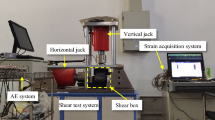Casing damage caused by shear stress has been detected in several areas of the Daqing oilfield. Such damage can be caused by marker bed slip in mud shale sections. However, the mechanism of slippage stress in mud shale horizontal sections is currently not well understood. Based on the effect of differences in interregional pore pressure, we have established a mechanical model of a cracked horizontal plane and obtained analytical solutions for the formation stress and displacement. In order to quantitatively characterize the relative slip distance in a horizontal section, the fault stick-slip and sliding weakening theories have been used. In this paper, based on a stick-slip theory, we propose a model to calculate the slip of a mud shale horizontal section under differing interregional pore pressures. The results show, that under the influence of differing formation pore pressure between the regions, the upper layer of the horizontal section intermittently slips towards the high-pressure center. When the pore water enters the formation, the friction between the sections decreases, causing a decrease in the weakened slip phenomenon. Consequently, the slippage of the formation section will increase under the conditions. The results of the study can provide useful background for preventing casing failures in mud shale marker beds.








Similar content being viewed by others
References
C.Hu, C. Ai, F. Tao, et al., “Optimization of well completion method and casing design parameters to delay casing impairment caused by formation slippage,” SPE/IADC Middle East Drilling Technology Conference and Exhibition, SPE: 178144-MS (2016).
G. Han, Y. Liu, K. Nawnit, and Y. Zhou, “Discussion on seepage governing equations for low permeability reservoirs with a threshold pressure gradient,” Adv. Geo-Energ. Res., 2(3): 245-259 (2018).
X. Wang and J. J. Sheng, “A self-similar analytical solution of spontaneous and forced imbibition in porous media,” Adv. Geo-Energ. Res., 2(3): 260-268 (2018).
C. Ai, C. Hu, Y. Li, et al., “Wellbore stability estimation model of horizontal well in cleat-featured coal seam,” SPE/EAGE European Unconventional Resources Conference and Exhibition, 2014, 1-9, SPE: 167767-MS (2014).
Y. Wang, X. Xia, Y. Wang, et al., “Using proper orthogonal decomposition to solve heat transfer process in a flat tube bank fin heat exchanger,” Adv. Geo-Energ. Res., 1(3), 158-170 (2017).
B. Shang, X. Han, S. Li, and K. Liu, “Research of water control technology for horizontal wells in water-driven reservoirs,” Adv. Geo-Energ. Res., 2(2), 210-217 (2018).
J. Li, T. Yu, X. Liang, et al., “Insights on the gas permeability change in porous shale,” Adv. Geo-Energ. Res., 1(2), 69-73 (2017).
W. Wei and Y. Xia, “Geometrical, fractal, and hydraulic properties of fractured reservoirs: A mini-review,” Adv. Geo-Energ. Res., 1(1), 31-38 (2017).
W. Wang, D. Zheng, G. Sheng, et al., “A review of stimulated reservoir volume characterization for multiple fractured horizontal well in unconventional reservoirs,” Adv. Geo-Energ. Res., 1(1), 54-63 (2017).
Z. Li, J. Song, G. Zhou, et al., “Cause and microscopic mechanism of casing damage in sandstone reservoir,” Energ. Sav. Pet. Petrochem., 21(8):40-42 (2005).
N. S. Adams, R. F. Mitchell, A. W. Eustes, et al., “A Causation investigation for observed casing failures occurring during fracturing operations,” SPE Hydraulic Fracturing Technology Conference and Exhibition, SPE-184868-MS (2017).
J, Wang, L. Han, Y. Li, et al., “Selection criteria and evaluation technology for casing used in shale gas wells in China,” SPE Asia Pacific Unconventional Resouces Conference and Exhibition, SPE:176859 (2017).
M. A. Biot, “General solutions of equations of elasticity and consolidation for a porous material,” J. Appl. Mech., 23, 91-96 (1956).
M. A. Biot, “Mechanics of deformation and acoustic propagation in porous media,” J. Appl. Phys., 33(4), 1482-1498 (1962).
Z. Xu, A Concise Tutorial on Elasticity, Higher Education Press, Beijing (2002).
M. Zhang and Z. Fu, Introduction to Earthquake Prediction, Science Press, Beijing (2001).
D. J. Andrews, “Dynamic plane-strain shear rupture with a slip-weakening friction law calculated by a boundary integral method,” Bull. Seismol. Soc. Am., 75(1), 1-21 (1985).
E. Fukuyama, T. Mikumo, K. B. Olsen, “Estimation of the critical slip-weakening distance: theoretical background,” Bull. Seismol. Soc. Am., 93(4), 1835-1840 (2003).
Author information
Authors and Affiliations
Corresponding author
Additional information
Translated from Khimiya i Tekhnologiya Topliv i Masel, No. 3, pp. 83–88, May–June, 2021.
Rights and permissions
About this article
Cite this article
Hu, C., Wang, F., Deng, Q. et al. Study on Reservoir Internal Stress Variation and Mud Shale Horizontal Section Slippage Induced by Interregional Pore Pressure Based on Stick-Slip Theory. Chem Technol Fuels Oils 57, 541–551 (2021). https://doi.org/10.1007/s10553-021-01276-1
Published:
Issue Date:
DOI: https://doi.org/10.1007/s10553-021-01276-1




